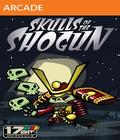Back in the mid-'90s, turn-based strategy games were all the rage among PC gamers. The genre was popular for a number of reasons, but one of its biggest draws was that games were won or lost based on decisions made by the player. Much like a game of chess, turn-based strategy didn't rely on random luck or a roll of the dice. It was all about planning.
When the genre came to consoles, games tended to focus on the tactical aspects, with titles like Advance Wars, Fire Emblem and the aptly named Final Fantasy Tactics being shining examples of the genre. Those are some lofty standards for a new competitor to live up to, yet Skulls of the Shogun manages to do just that.
The beauty of Skulls of the Shogun is in its simplicity. Rather than overwhelm the player with massive numbers of units, it provides the minimum necessary to get the job done. Basic units come as archers, cavalry and infantry. Magic users are monks and split across healing, destruction and troublemaking. Your general is similar to infantry units, though slightly more buff. He causes more damage and gets extra turns, but if he dies, you lose the fight.
Movement is displayed in an easy-to-read fashion, with each unit's movement radius shown as a circle. As you move, the circle contracts, providing an easy way to see a particular unit's reach. If you have movement left after attacking, it is possible to retreat, but if you use all your movement to reach the enemy, your fighter will be stuck at the front lines until the next round.
Damage is equally straightforward, as Skulls of the Shogun doesn't hide any information. Before attacking, you always know the chance of a hit as well as the damage to be dished out. If an enemy isn't killed, it can retaliate, so that factors into your combat decisions. Certain units are limited in their attacks, which smart players will use to their advantage. For example, if an infantry unit attacks an archer, the archer cannot retaliate because the infantry unit is too close.
In addition to normal damage, when attacking a single unit, you can push it back. Normally, this isn't a big deal, but if a unit is near a ledge, it is possible to attack and push it over the side to its death. Only single units are vulnerable to this; groups of two or more cannot have their lines broken unless one of the units is killed.
Adding another twist to combat are the skulls. Each defeated enemy leaves behind a skull. Instead of attacking, you have the option of feeding the skull to a unit. Each skull a unit eats (up to three) heals damage and makes it more powerful. This is a limited effect (only good for the current level), but used wisely, it can be a very powerful tool. Eat skulls at the wrong time, though, and you leave yourself open to attack.
While all of the different elements are easy enough to grasp, it is the intricate balance with which they are put together that really makes the game shine. Skulls of the Shogun does a smashing job of introducing gameplay elements in a structured fashion and then letting you experiment with them. It's interesting because when a mistake is made, you usually realize it right after confirming the move. Some mistakes are mere setbacks; others are guaranteed losses.
Because of the structured nature, there is a surprising amount of replay value within Skulls of the Shogun. The more you play, the more your strategic arsenal grows. Moves and strategies that would have never occurred to you on a first playthrough are suddenly second nature. An achievement that rewards a low total time makes a speed run through Skulls of the Shogun feel oddly similar to playing a few rounds of speed chess.
Unfortunately, Skulls of the Shogun doesn't seem to have caught on as a multiplayer game. When we checked on multiple occasions, there simply wasn't anyone playing online. Thankfully, the game offers up competitive local play for up to four contenders, which makes it easy to battle on a single screen. The nature of the game lends itself well to local play.
Skulls of the Shogun also boasts an intriguing asynchronous play option, similar to the play-by-email modes in PC games of old. In this type of multiplayer, you make a move and then wait for an opponent. The time lag can be great, but it allows for play between Xbox 360, Windows 8 and Windows Phone versions of the game. By the same token, the game also saves your progress across platforms, so if you start playing on one, you can finish on another.
Gameplay may be the strongest point in Skulls of the Shogun, but presentation is nearly as impressive. Visually, the game looks like a mash-up of a Flash game and an '80s Saturday morning cartoon — albeit one with a decidedly mature flair. Dialogue is flippant and funny, never afraid to break the fourth wall if it would make for a good joke. At the same time, the story is both coherent and consistent.
The humor runs the gamut from teenage sex jokes to obscure gamer references. As if to prove its "gamer cred," one of the loading screens even offers up a fake CD cover for the game, made up in a style that is reminiscent of Japanese SEGA Saturn games.
Skulls of the Shogun is irreverent, challenging and, most of all, fun. It masterfully mixes humor with well-balanced gameplay to keep players coming back for more. If strategy is your thing, this is a must-buy.
Score: 9.0/10
More articles about Skulls of the Shogun










 Washing up on the shores of the afterlife, players meet and join forces with vibrant ghost-samurai warriors, magical animal-monks, and mustachioed samurai generals on the way to capture Skulls of the Shogun.
Washing up on the shores of the afterlife, players meet and join forces with vibrant ghost-samurai warriors, magical animal-monks, and mustachioed samurai generals on the way to capture Skulls of the Shogun.
































